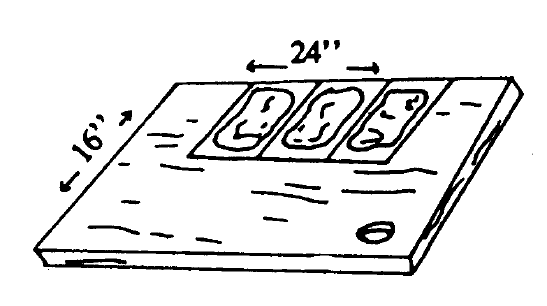Reducing Snake Problems Around Homes
Snakes in and around homes can cause many people to worry. Knowing more about snakes will help you understand how to handle situations when they are encountered.
Snakes are “cold-blooded,” which means they are unable to internally control their body temperature. They seek places in their environment that can help them stay cool during hot summer months or warm during cool fall and spring weather.
Snakes are predators. Depending upon their size, they feed on prey ranging in size from insects or eggs to small mammals, lizards, birds, or even other snakes. If they are living around a home or other human dwelling, they are doing so because there is food, shelter, or other habitat features for them.
For your safety, it is important to be able to identify snakes as venomous or nonvenomous. In most cases, the snakes seen around houses are harmless species such as garter, ribbon, ringneck, king, or rat snakes. Mississippi does have six types of venomous snakes: copperhead, coral snake, pygmy rattlesnake, eastern diamondback rattlesnake, canebrake or timber rattlesnake, and cottonmouth or water moccasin. A good field guide to reptiles can help you identify snakes and understand their habits. You may also consult Extension Publication 3529 Snakes Alive! How to Identify Hazardous Snakes to learn more about them.
Control Snake Problems
Manage Habitat
The best way to discourage snakes around a home is to make the area unattractive to them. Remove their habitat, including hiding places, foraging areas, and food resources.
In early spring, snakes are attracted to warm spots, such as metal, rocks, or other heat-conducting items. In warm months, they seek out cool, damp, sheltered areas. To reduce their options for shelter around a house, remove nearby cover, including weedy growth, brushy fence rows, piles of boards or firewood, rock or brick piles, and leaf or grass piles. Keep the lawn mowed around the perimeter of a home to minimize hiding places. Check around walkways or porches for cracks or holes that might provide shelter for snakes.
If you store firewood, keep the stack away from the house. You can store wood for a while near the house in cold months when snakes are inactive. Use a rack to keep the firewood at least 12 inches above the ground. Snakes are discouraged from using the wood for shelter if it is separated from the ground surface.
Any structure or vegetation that provides a home for small rodents (mice and rats) is attractive to the snakes that prey on them. Put food resources for rodents, such as pet or bird food, in secure closed containers to discourage rodents and the snakes that feed on them.
Exclusion
Check around the base of homes, storage sheds, or barns. If snakes can crawl under them for protective cover or prey, close off access with packed soil or building materials such as bricks, sheet metal, or small-mesh hardware cloth. Use a barrier that extends about 6 inches below the soil surface. Snakes may push through loose soil, and they use holes made by mice and other rodents, but they cannot dig through hard soil.
Check around the foundation of your home for cracks or openings where snakes, mice, or other unwanted guests might enter. Close all openings larger than a quarter of an inch, and use latex caulk or insulating foam around any gaps where surface wires or pipes enter. Seal cracks in masonry foundations (poured concrete, concrete blocks, or bricks) with mortar. Repair holes in wooden buildings with sheet metal or fine-mesh metal hardware cloth.
For rural homes, be sure snakes cannot get in septic or treatment plant drainpipes. If the pipe or tile is open at the end, cover it with ¼-inch mesh hardware cloth. Check periodically to be sure the wire doesn’t interfere with drainage.
Chemical Controls
No fumigants or toxicants are federally registered for snake control. Diet, body temperature, and other biological aspects of snakes complicate the potential for developing such control methods.
Repellents
Repellents are questionable at best for effectiveness at keeping snakes away from homes. No repellents are currently registered for snake control.
Various home remedies have been suggested for repelling snakes, and several have been tested to determine if they repel black rat snakes. Treatments included sulfur, lime, moth balls, gourd vines, sisal rope, cayenne pepper spray, artificial skunk scent, a tacky bird repellent, coal tar and creosote, and musk from a king snake (eats other snakes). None of these worked.
Some sticky materials, when applied in 18-inch bands around supporting poles, prevented snakes from climbing to wood duck nest boxes. This approach may keep snakes away from bird nest boxes mounted on poles, but otherwise it is not practical.
Removal from Inside a Building
Snakes occasionally enter houses. One good way to remove a snake is to sweep it with a broom into a box that can be sealed, and then release the snake as far away from houses as possible. It usually serves very little practical purpose to kill the snake. In fact, many snakes provide great benefit to humans by keeping rodent populations low.
If you cannot find the snake to capture it but think one is in your home, consider using the rumpled cloth or glue trap techniques described in the next section of this publication. Unless you are skilled at snake identification, treat all snakes as if they are venomous and avoid contact with the snake’s head. Do not try to grab a snake by the tail because the snake can quickly strike the hand that is holding it.
Trapping
Attract snakes for capture by placing rumpled damp cloths, such as pillowcases, on the floor near a place the snake is likely to be. Cover the cloths with a dry cloth to slow evaporation. The rumples provide spaces for snakes to enter under the cloth. Snakes like the cloths because they provide a cool, damp, dark place for them to hide. Check the site periodically to see if the snake has curled up in the cloth. If so, pick up the snake and pile of cloths with a scoop shovel or pitchfork. Quickly place them in a large box, and carry them away.
You can also capture snakes indoors using rodent glue boards. One glue board arrangement will capture snakes up to 6 feet long. Use a ¼-inch plywood board that is about 16 by 24 inches. Tack or glue two to four rodent glue boards along one side. Drill a hole with a ¾-inch diameter in an opposite corner (see the drawing on the top left). Insert a rope or pole with a hook on the end into the hole to remove the board and snake. You may need to trim the edges of plastic-tray glue traps to provide a flat surface.
Place the board against an open section of wall where the snake is likely to travel but away from pipes or other objects the snake might use for leverage to escape.
Remove and release captured snakes by pouring common cooking oil on them. The oil breaks down the glue. You can then remove the snakes, unharmed, with a stick or a pole. Only use glue boards indoors or under outdoor structures. Note that glue traps are not discriminating, and nontarget creatures can be caught unintentionally, so be sure children, pets, or wild animals cannot reach them. Despite the aid of cooking oil, the glue is messy and difficult to remove.
For removing snakes outdoors or around homes, commercial trap designs generally are impractical. A simple technique based on scientists’ field methods involves the use of small boards (1 to 2 square feet) placed on the ground. Snakes may hide under the boards for shelter. Check periodically under the boards for snakes. Keep in mind that placing boards around your house may improve snake habitat, which could attract rather than repel them.
Beneficial Aspects of Snakes
Snakes are an important part of our natural world. They are beneficial to people in many ways, but it is best for both people and snakes if we keep them out of homes.
Snake venom is used in medical research and has benefitted people in unexpected ways. One example is the development of a widely used blood-pressure medicine based on the chemical aspects of snake venom. Other research is testing snake poisons to treat blood and heart problems and to control harmful bacteria.
Snakes kill and eat rats, mice, insects, moles, and other pests, which helps to control their numbers. King, milk, black racer, and eastern indigo snakes commonly eat other snakes, including venomous ones. Snakes are particularly effective because they can capture pests in areas other predators cannot access.
Legal Status
Most snakes in Mississippi are not protected by state or federal law, but all snakes do come under the state’s regulatory authority. No native snake or snake part may be bought, sold, or in any way entered into commercial trade. Black pine, eastern indigo, rainbow, and southern hognose snakes are listed as endangered in Mississippi. By federal law, the eastern indigo and black pine snakes are listed as threatened.
Check with the Mississippi Department of Wildlife, Fisheries, and Parks Museum of Natural Science in Jackson, Mississippi, if you have questions or concerns. Even though most snakes in Mississippi are not legally protected, it is better to leave them alone when they are not causing a problem.
See PDF for images of snakes.
Publication 2277 (POD-10-23)
Revised by Leslie M. Burger, PhD, Associate Teaching Professor, Wildlife, Fisheries, and Aquaculture. Most of the photos in this publication came from CanStockPhoto.com or iStockPhoto.com. The eastern coachwhip snake photo was taken by Jesus Marino of the United States Fish and Wildlife Service.
The Mississippi State University Extension Service is working to ensure all web content is accessible to all users. If you need assistance accessing any of our content, please email the webteam or call 662-325-2262.




